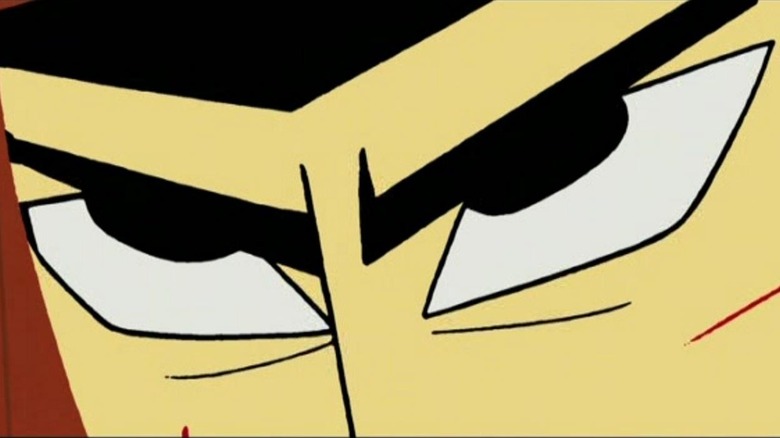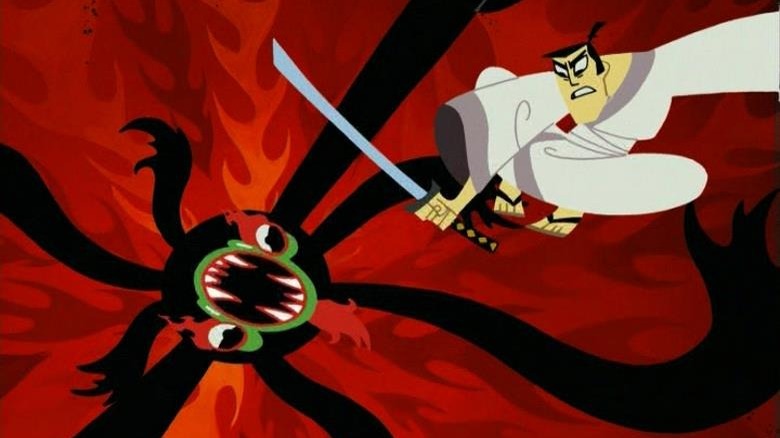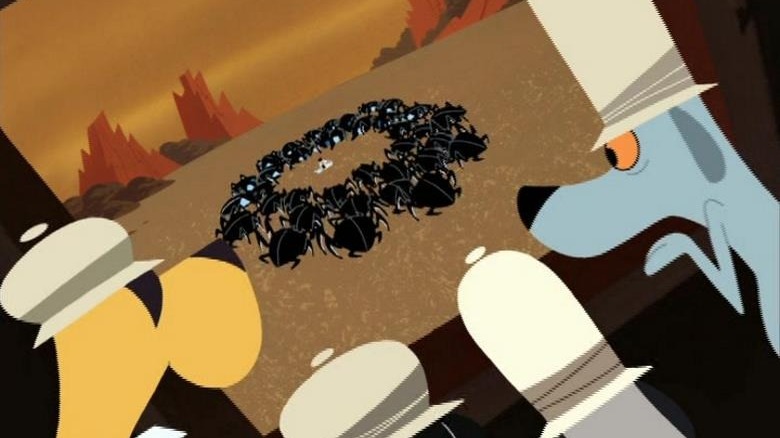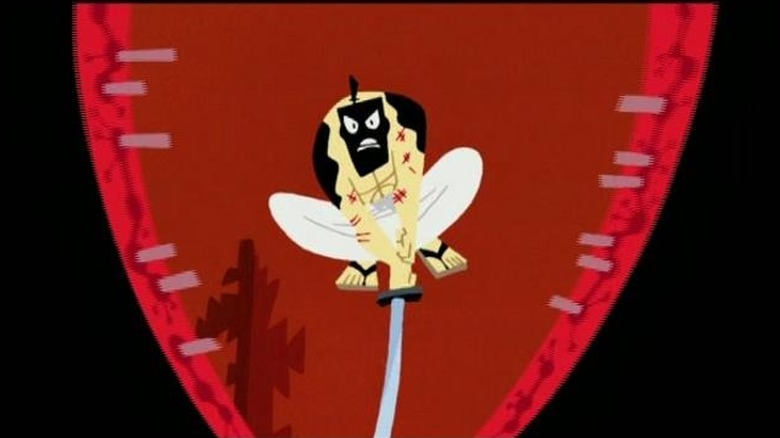How A 10-Year-Old Genndy Tartakovsky Came Up With Samurai Jack
"Samurai Jack" gave me something I didn't know I wanted as a kid, which was violence. At the climax of the show's "Premiere Movie," Jack defends a pack of hapless dogs from an army of mechanical beetles commanded by the demon Aku. The beetles are impaled, decapitated, blasted by rocket fire. As Jack slices them in half, oil spurts from their severed pipes. Jack is bathed in this black filth. As a child I could not process what I was seeing. The sea of beetles swallowing the red hills, the repeated swing of Jack's sword, and the rictus of his face was like a nightmare. But that is why "Samurai Jack" succeeds, beyond its remarkable style. It delivers everything a kid could want — samurai, monsters, robots — at a level of intensity just outside of their comfort zone.
Jack's story was no nightmare for Genndy Tartakovsky, the creator of "Samurai Jack." "I had the same dream since I was 10," he said in an interview with The Verge, "about the world being destroyed and run by mutants. I'd find a samurai sword, pick up a girl I had a crush on, and we'd go through the land, surviving." Any pulp artist on autopilot can regurgitate these ideas, pretending they're channeling their inner child when the child of their memories died long ago. Tartakovsky's strength is he is never on autopilot. He always finds something to latch onto. Even in a movie like "Hotel Transylvania 2," saddled with a weak script and heavy producer interference, you can tell from the expressive designs and movement that you are watching a Tartakovsky production.
No mortal can hurt the great Aku
At 2020's Chicago Comic & Entertainment Expo, Genndy Tartakovsky spoke at a panel about his early career. As a child in Soviet Russia, he grew up watching a cartoon called "Well Just You Wait!" Picture a very Russian "Tom and Jerry," starring an oblivious rabbit and a long-suffering wolf, and you just about have it. When Tartakovsky's family moved to the United States, he fell in love with "Looney Tunes" and "Popeye." He carried these influences with him to university, where he abandoned his career path as an advertiser to pursue animation full time. After a year at the California Institute of the Arts, a university famous for its animation school, he followed a winding road to Hanna-Barbera, Cartoon Network, and his first big success, "Dexter's Laboratory."
You might think the stylish violence of "Samurai Jack" is a world away from "Looney Tunes." But watch the climax of the "Premiere Movie," and think again. Jack's battle against the robot beetles is more or less a series of gags, a "Road Runner" cartoon reconstructed as an epic battle. The beetles come after Jack, they stumble into a trap and are dispatched in hilarious detail. Repeat until the ground is covered in motor oil. "Popeye," too, remains near and dear to Tartakovsky's heart. He directed "Hotel Transylvania" at Sony to earn a swing at the "Popeye" movie of his dreams, a take that would "elicit laughs from just movement" rather than the script-driven gags of so many modern animated movies. Tartakovsky's proposal was rejected by the studio, but an 87-minute animatic of the project was leaked in July 2022.
You may have beaten me now
In interviews, Genndy Tartakovsky insists his approach remains the same as it was when his team produced "Samurai Jack." When The Verge asked how the final season of "Samurai Jack" was made, he confessed "we just use Photoshop ... we would have made the same show 10 years ago." In an interview with Animation World about his recent series "Primal," a near-wordless prehistoric drama about a man and his dinosaur, Tartakovsky insists the series is "basically traditional animation done on a Cintiq in TVPaint." Retaining the feel of his early work is clearly important to him. But there is also a clear progression throughout his career, a whittling down of dialogue and extraneous detail to a core of wordless cinematic action. "Primal" is just the most extreme expression of an approach leading back to "Clone Wars," "Samurai Jack," and perhaps even Tartakovsky's contributions to "Powerpuff Girls."
"Samurai Jack" lacks the elaborate world building and character drama of other cult TV animation classics like "Gargoyles." It exists within the limitations of its medium, rather than rupturing them. But there's a confidence to the series, an aesthetic consistency, that captures the imagination of children regardless. Tartakovsky discusses this approach in the aforementioned Verge interview. It's "kind of pulpy, and very specific to its own world. It's something that the 12- or 14-year-old kid in me just loves." "Samurai Jack" may be recycled from the daydreams of 10-year-old Genndy Tartakovsky, but its delivery is fully committed to the integrity of its world even when that world is purely ridiculous.
But I will destroy you in the future
When I rewatched the end of "Samurai Jack: The Premiere Movie" for this article, I was struck by the discrepancies in my memory compared to the actual work. I thought the eyes of the beetles were red, but they were blue, while the background was red. I remembered the intense violence, but I had forgotten the humor, and the way the series uses pans and repeated footage to suggest intensity while saving money on production. It had been so long since I had seen "Samurai Jack" that my dream of the series had replaced the real thing.
But perhaps that is to be expected. In that Verge interview, Tartakovsky suggests that as an artist or a storyteller, "you want to create an experience — comical, emotional, horror — that gives the viewer a reaction." As a 10 year old watching "Samurai Jack," a series dreamed by animators who were once 10 years old themselves, I was right where they wanted me. A "lasting memory" was created, a scar that would follow me into adulthood. That scar remained even as the details of "Samurai Jack" itself faded from my memory. Whether we're talking about fine art or pulp, there's nothing more powerful than that.



